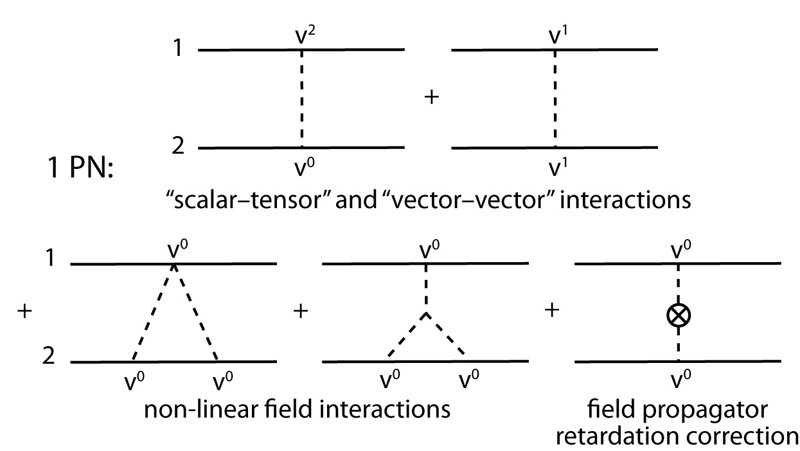Michele's research
Searching for GWs from coalescing black-hole and neutron-star binaries
Coalescing black-hole–black-hole and neutron-star–black-hole binaries are among the most promising sources for second-generation ground-based interferometers, but to detect them efficiently and extract their parameters accurately we need to model their gravitational waveforms very faithfully: GW searches work by systematically correlating the detector output with families of theoretical signal templates, and selecting the best-matching candidates.

Gravitational waves from a coalescing neutron-star binary (credit: NASA).
Modeling inspiraling binaries with effective-field-theory techniques
Together with CMU's Ira Rothstein and my JPL postdoc Chad Galley, I have been leading an effort to develop spinning-binary templates that are consistently accurate to 3.5PN order, as high as currently available nonspinning models, using techniques from effective field theory.
This approach maps the complex integrals of post-Newtonian theory into the computation of Feynman diagrams, which can rely on 50 years of experience in quantum field theory. The biggest difficulties lie in bookkeeping a large number of Feynman diagrams, and calculating the hardest sub-diagram integrals using strategies from multi-loop calculations in particle physics.

The five diagrams that generate individual terms in the 1PN Einstein–Infeld–Hoffmann potential.
Signal models for compact-object inspirals
Between 2001 and 2005 I worked with Alessandra Buonanno, Yanbei Chen, and Yi Pan to devise robust families of signal templates for the inspiraling binaries sought by LIGO.
We first developed a phenomenological template family, BCV, that could embed all credible (but discordant) post-Newtonian resummations at the late stage of inspiral.
-
Detection template families for gravitational waves from the final stages of binary--black-hole inspirals: Nonspinning case
A. Buonanno, Y. Chen, and M. Vallisneri*
Phys. Rev. D 67, 024016 (2003) [+]
We then tackled the effects of spins, which can induce strong precession-induced modulations in the signals, requiring a prohibitively large number of parameters to describe them. We developed a family of modulated detection templates, BCV2, which are functions of very few physical and phenomenological parameters, but model spin effects remarkably well.
-
Detecting gravitational waves from precessing binaries of spinning compact objects: II. Search implementation for low-mass binaries
A. Buonanno, Y. Chen, Y. Pan, H. Tagoshi, and M. Vallisneri*
Phys. Rev. D 72, 084027 (2005) [+] -
Detecting gravitational waves from precessing binaries of spinning compact objects: Adiabatic limit
A. Buonanno, Y. Chen, and M. Vallisneri*
Phys. Rev. D 67, 104025 (2003) [+]
We also created a separate template family for spinning binaries, PBCV, which consists of essentially exact waveforms written directly in terms of the physical parameters of the binary, and which can be used in a fast matched-filtering scheme. The crucial insight was a new decomposition of detector response into a time-dependent component that encodes the binary evolution, and a constant component that represents the relative position and orientation of detector and binary.
-
Physical template family for gravitational waves from precessing binaries of spinning compact objects: Application to single-spin binaries
Y. Pan, A. Buonanno, Y. Chen, and M. Vallisneri*
Phys. Rev D 69, 104017 (2004) [+] -
Quasiphysical family of gravity-wave templates for precessing binaries of spinning compact objects: Application to double-spin precessing binaries
A. Buonanno, Y. Chen, Y. Pan, and M. Vallisneri*
Phys. Rev. D 70, 104003 (2004) [+]
Searches for compact-object inspirals in LIGO data
Our template families were used in the LIGO searches for inspiraling binaries in data from science runs S2, S3, and S4.
-
Search for gravitational waves from binary black-hole inspirals in LIGO data
LSC
Phys. Rev. D 73, 062001 (2006) [+] -
Search for gravitational waves from binary inspirals in S3 and S4 LIGO data
LSC
Phys. Rev. D 77, 062002 (2008) [+] -
Search of S3 LIGO data for gravitational wave signals from spinning black hole and neutron star binary inspirals
LSC
Phys. Rev. D 78, 042002 (2008) [+]
I also participated directly in the analysis of the LIGO data from science run S5, and in the development of the ihope detection pipeline.
-
Searching for gravitational waves from binary coalescence
S. Babak et al.*
Phys. Rev. D 87, 024033 (2013) [+] -
Search for Gravitational Waves from Low Mass Compact Binary Coalescence in 186 Days of LIGO's fifth Science Run
LSC
Phys. Rev. D 80, 047101 (2009) [+]
Back to research gallery.
© M. Vallisneri 2014 — last modified on 2013/01/31